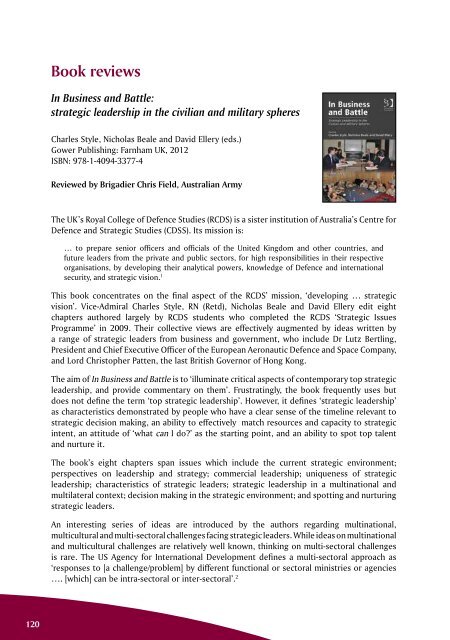190%202013%20Mar_Apr
190%202013%20Mar_Apr
190%202013%20Mar_Apr
Create successful ePaper yourself
Turn your PDF publications into a flip-book with our unique Google optimized e-Paper software.
120<br />
Book reviews<br />
In Business and Battle:<br />
strategic leadership in the civilian and military spheres<br />
Charles Style, Nicholas Beale and David Ellery (eds.)<br />
Gower Publishing: Farnham UK, 2012<br />
ISBN: 978-1-4094-3377-4<br />
Reviewed by Brigadier Chris Field, Australian Army<br />
The UK’s Royal College of Defence Studies (RCDS) is a sister institution of Australia’s Centre for<br />
Defence and Strategic Studies (CDSS). Its mission is:<br />
… to prepare senior officers and officials of the United Kingdom and other countries, and<br />
future leaders from the private and public sectors, for high responsibilities in their respective<br />
organisations, by developing their analytical powers, knowledge of Defence and international<br />
security, and strategic vision. 1<br />
This book concentrates on the final aspect of the RCDS’ mission, ‘developing … strategic<br />
vision’. Vice-Admiral Charles Style, RN (Retd), Nicholas Beale and David Ellery edit eight<br />
chapters authored largely by RCDS students who completed the RCDS ‘Strategic Issues<br />
Programme’ in 2009. Their collective views are effectively augmented by ideas written by<br />
a range of strategic leaders from business and government, who include Dr Lutz Bertling,<br />
President and Chief Executive Officer of the European Aeronautic Defence and Space Company,<br />
and Lord Christopher Patten, the last British Governor of Hong Kong.<br />
The aim of In Business and Battle is to ‘illuminate critical aspects of contemporary top strategic<br />
leadership, and provide commentary on them’. Frustratingly, the book frequently uses but<br />
does not define the term ‘top strategic leadership’. However, it defines ‘strategic leadership’<br />
as characteristics demonstrated by people who have a clear sense of the timeline relevant to<br />
strategic decision making, an ability to effectively match resources and capacity to strategic<br />
intent, an attitude of ‘what can I do?’ as the starting point, and an ability to spot top talent<br />
and nurture it.<br />
The book’s eight chapters span issues which include the current strategic environment;<br />
perspectives on leadership and strategy; commercial leadership; uniqueness of strategic<br />
leadership; characteristics of strategic leaders; strategic leadership in a multinational and<br />
multilateral context; decision making in the strategic environment; and spotting and nurturing<br />
strategic leaders.<br />
An interesting series of ideas are introduced by the authors regarding multinational,<br />
multicultural and multi-sectoral challenges facing strategic leaders. While ideas on multinational<br />
and multicultural challenges are relatively well known, thinking on multi-sectoral challenges<br />
is rare. The US Agency for International Development defines a multi-sectoral approach as<br />
‘responses to [a challenge/problem] by different functional or sectoral ministries or agencies<br />
…. [which] can be intra-sectoral or inter-sectoral’. 2


